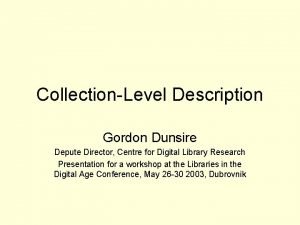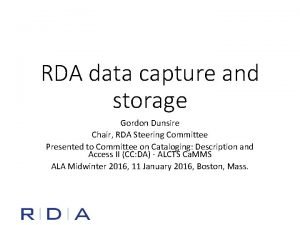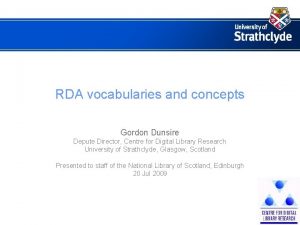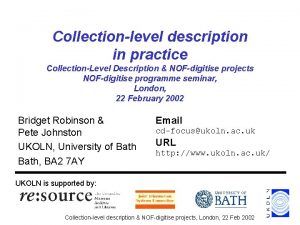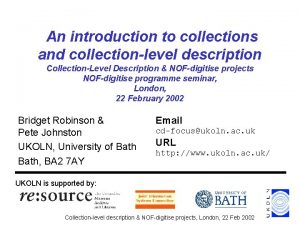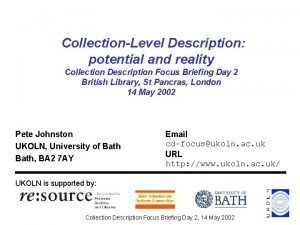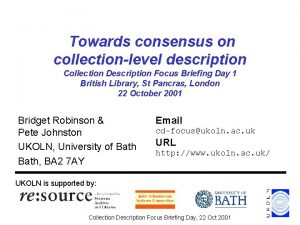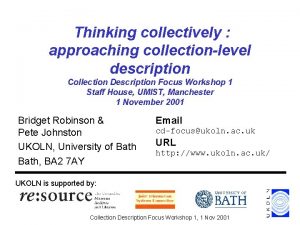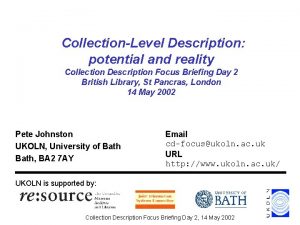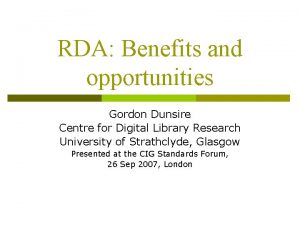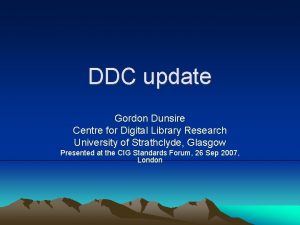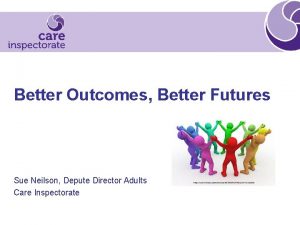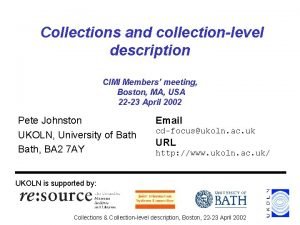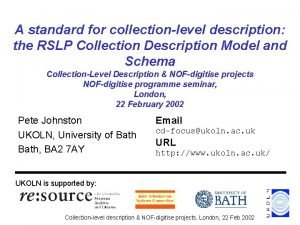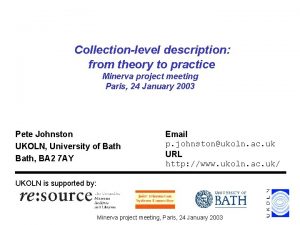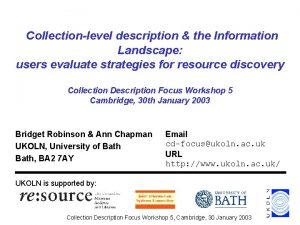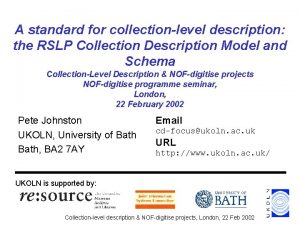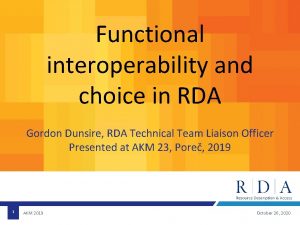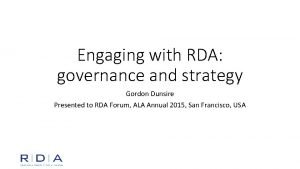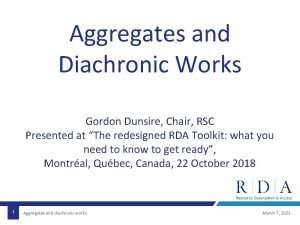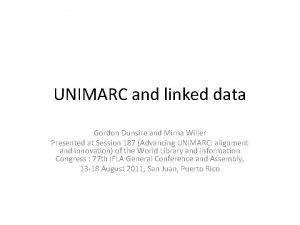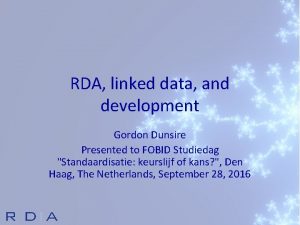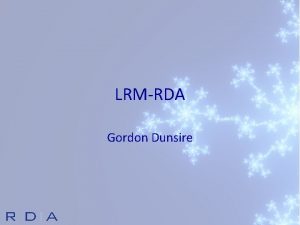CollectionLevel Description Gordon Dunsire Depute Director Centre for






















![IE for Scotland (A) Entry Initial landscape [Scottish Cultural Portal; SCONE] Survey Collection descriptions IE for Scotland (A) Entry Initial landscape [Scottish Cultural Portal; SCONE] Survey Collection descriptions](https://slidetodoc.com/presentation_image/7f72ae29f2d3271f7c22be5269ea1ab1/image-23.jpg)
![IE for Scotland (B) Discover Distributed union catalogue [CAIRNS] Harvested union catalogue [Ha. IRST] IE for Scotland (B) Discover Distributed union catalogue [CAIRNS] Harvested union catalogue [Ha. IRST]](https://slidetodoc.com/presentation_image/7f72ae29f2d3271f7c22be5269ea1ab1/image-24.jpg)

- Slides: 25

Collection-Level Description Gordon Dunsire Depute Director, Centre for Digital Library Research Presentation for a workshop at the Libraries in the Digital Age Conference, May 26 -30 2003, Dubrovnik

Overview • • What is a collection? What is collection-level description? Why is it important? Development in UK Some practical issues Scottish Collections Network (SCONE) Information environments

What is a collection? • “Any aggregation of individual items (objects, resources)” – – CD Focus briefing paper 1 Size is not a factor – 1 item is possible Varying degrees of permanence Physical juxtaposition not necessary; collections can be distributed across multiple locations • Cross-domain – Libraries, museums, art galleries, archives, digital • Definition is too vague to be practicable – Limit to “useful” collections • “Useful” defined in terms of “Functional granularity”

Functional granularity • “… useful or necessary for the purposes of resources discovery or collection management” – Heaney – As deemed by “the institution” – Might include user groups as well as owners and administrators • Exclude – Dynamic collections (results of retrieval) – Single persons (unless significant)

What is CLD? • Collection-Level Description – Metadata at the level of aggregation: Title: William Speirs Bruce Collection Description: Collection of material on oceanography and Arctic and Antarctic exploration, bequeathed by Dr. William Speirs Bruce, Polar explorer and oceanographer (1867 -1921). Location: Edinburgh University Library. Main Library Collectors: William S. (William Speirs) Bruce (1867 -1921) [Collecting: Closed] Subjects: Antarctica--Discovery and exploration Part of: Edinburgh University Library. Department of Special Collections printed books collections

Confusing terms • Collection-Level Description – The complete metadata for a collection – The process of creating a CLD • Collection-Description – A finding-aid for the collection (e. g. catalogue) • Description – An attribute of a Collection giving a short summary of the collection history and contents, etc.

Why is CLD important? (1) • Ideally, all metadata/retrieval is at the level of the work (item-level description) • But in the Real world … – Online ILD metadata not available • Legacy; Institutional policies – Wide variation in ILD structure and content standards • Between domains; within domains • Within single institutions!

Why is CLD important? (2) • CLD offers broader coverage – More stuff can be found – Cheaper to implement – High recall, low precision • Some metadata cannot be accommodated in ILD without extensive duplication – E. g. Collection title, Collector, Owner, Location, etc.

Why is CLD important? (3) • Collaborative management – Collaborative acquisition policies – Preservation and storage – Priorities for digitisation, wider access, etc. • Landscaping in distributed digital information environments – Portals – Broad overview, then more precise discovery

Landscaping Search term or Profile parameter e. g. name, subject, education level, accessibility Retrieve relevant CLDs to create broad "map" of concentrations of resources: peaks of significance; "lodes" for further exploration CLDs link to digital collections, and online (analytic) finding aids Local ILDs for resource discovery: cross-searching possible with Z 39. 50/OAI

Development of CLD in UK • Entity-relationship model – Michael Heaney – Also covers analytic finding aids: collectiondescriptions (C-Ds) • Database schema – For RSLP by UKOLN; simplifies Heaney’s model • Implementation – JISC IE Services Registry; simplifies RSLP

Heaney’s Analytic Model

Heaney's components • Entities – Collection; Agent; Location • Relationships – Collection: Is. Located. In: Location – Administrator[Agent]: Administers: Location – Collector[Agent]: Collects: Collection – * Collection: Has. Part: Collection – * Collection: Is. Described. By: C-D[Collection] * Heaney focussed on single collections

CLD in practice (1) • Collection titles – If no specific title, derive from name of institution or user group defining the collection • Collection hierarchies – Multi-level granularity (6 levels in SWOP) – Polyhierarchy: one physical super-collection, but many virtual – Data redundancy; inheritance from supercollection • E. g. location, owner, access

CLD in practice (2) • Content interoperability – Cross-searching names and subjects in landscapes – Varying standards in different organizations • Agent names (persons and organizations) – Much wider range than item-level description • Owners, administrators in addition to creators, subjects, to be included in name authority files • Subjects – Collections on specific subjects – General collections; subject strengths

CLD in practice (3) • Dates – 18 th century books on classical Greece collected from 1890 to 1930 – dates of: manufacture; subject; aggregation • Significance – Quantity vs quality; subjective; dynamic – 5 first editions with manuscript notes by Robert Burns, or 50000 items by and about Burns?

SCONE story (1) • CAIRNS – Z 39. 50 clump for distributed searching – Metadata for Z servers (service-level description!) – Associated metadata for collectiondescriptions (catalogue indexes, etc. ) – Associated metadata for CLDs – Access (SQL) database

SCONE story (2) • SCONE project – Collaborative collection management • HE/FE plus public libraries sector (SEED) • CDLR as lead site – Test datasets • SLIR; SWOP; ESH; Websites – Then Heaney's model and RSLP schema • SCONE service – 2600 CLDs

SCONE story (3) • SQL database (MS SQL Server) – Uses Heaney’s analysis rather than RSLP – Fully relational, normal form – Incorporates additional metadata not specified • Subject strengths (RCO) • Service-level description elements (CAIRNS) • Cold. Fusion Web data server • Dream. Weaver Website maintenance

SCONE futures • CC-interop (COPAC/Clumps interoperability) project – Cross-relates SCONE to major UK schemas – SCONE clone for RIDING clump • Ha. IRST (institutional resources) and SPEIR (Scottish portals) projects – SCONE used for landscaping

JISC Information Environment • “the set of network or online services that support publishing and use of information and learning resources” • Functional model for resource discovery has 4 stages – Observes that some components already exist or are under development

JISC IE Functional Model • 1: Enter – Initial landscape: presentation of collections & services for local service or user profile • 2: Survey – Modify set of collections & services • 3: Discover – Item-level searching using distributed (z 39. 50) or physical (OAI harvested; FTP) union catalogue • 4: Detail – Further information about items
![IE for Scotland A Entry Initial landscape Scottish Cultural Portal SCONE Survey Collection descriptions IE for Scotland (A) Entry Initial landscape [Scottish Cultural Portal; SCONE] Survey Collection descriptions](https://slidetodoc.com/presentation_image/7f72ae29f2d3271f7c22be5269ea1ab1/image-23.jpg)
IE for Scotland (A) Entry Initial landscape [Scottish Cultural Portal; SCONE] Survey Collection descriptions service [SCONE] Landscaper Collection-level descriptions
![IE for Scotland B Discover Distributed union catalogue CAIRNS Harvested union catalogue Ha IRST IE for Scotland (B) Discover Distributed union catalogue [CAIRNS] Harvested union catalogue [Ha. IRST]](https://slidetodoc.com/presentation_image/7f72ae29f2d3271f7c22be5269ea1ab1/image-24.jpg)
IE for Scotland (B) Discover Distributed union catalogue [CAIRNS] Harvested union catalogue [Ha. IRST] Union catalogue [COPAC] Detail Item metadata

Links • Me – g. dunsire@strath. ac. uk • SCONE service – http: //scone. strath. ac. uk/service/index. cfm – “About SCONE” for more information • CDLR (other projects) – http: //cdlr. strath. ac. uk • JISC Information Environment – http: //www. jisc. ac. uk/index. cfm? name=about_info_en v
 Gordon dunsire
Gordon dunsire Gordon dunsire
Gordon dunsire Organy administracji publicznej
Organy administracji publicznej Brian gordon director
Brian gordon director Centroid in mechanics
Centroid in mechanics Difference between centroid and centre of gravity
Difference between centroid and centre of gravity Indikation för kejsarsnitt på moderns önskan
Indikation för kejsarsnitt på moderns önskan Karttecken
Karttecken För och nackdelar med firo
För och nackdelar med firo Blomman för dagen drog
Blomman för dagen drog Rbk-mätning
Rbk-mätning Redogör för vad psykologi är
Redogör för vad psykologi är En lathund för arbete med kontinuitetshantering
En lathund för arbete med kontinuitetshantering Mat för idrottare
Mat för idrottare Bris för vuxna
Bris för vuxna Offentlig förvaltning
Offentlig förvaltning Frgar
Frgar Datorkunskap för nybörjare
Datorkunskap för nybörjare Plagg i rom
Plagg i rom Större och mindre tecken
Större och mindre tecken Orubbliga rättigheter
Orubbliga rättigheter Steg för steg rita
Steg för steg rita Ministerstyre för och nackdelar
Ministerstyre för och nackdelar Tack för att ni lyssnade bild
Tack för att ni lyssnade bild Bästa kameran för astrofoto
Bästa kameran för astrofoto Plats för toran ark
Plats för toran ark
